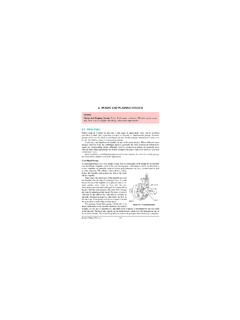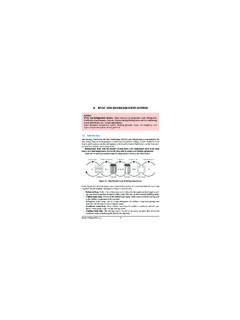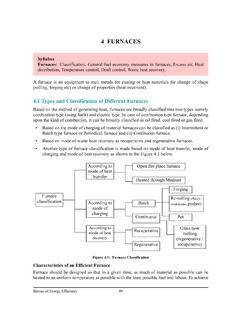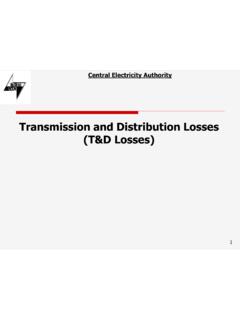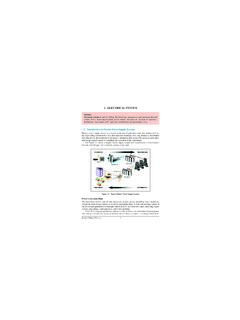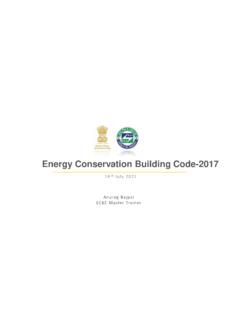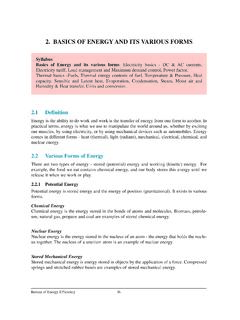Transcription of 4. MATERIALAND ENERGY BALANCE
1 79 Bureau of ENERGY Efficiency4. MATERIAL AND ENERGY BALANCES yllabusMaterial and ENERGY BALANCE :Facility as an ENERGY system, Methods for preparingprocess flow, Material and ENERGY BALANCE quantities, as they pass through processing operations, can be described by materialbalances. Such balances are statements on the conservation of mass. Similarly, ENERGY quanti-ties can be described by ENERGY balances, which are statements on the conservation of there is no accumulation, what goes into a process must come out. This is true for batch oper-ation. It is equally true for continuous operation over any chosen time and ENERGY balances are very important in an industry. Material balances are fun-damental to the control of processing, particularly in the control of yields of the products. Thefirst material balances are determined in the exploratory stages of a new process, improved dur-ing pilot plant experiments when the process is being planned and tested, checked out when theplant is commissioned and then refined and maintained as a control instrument as productioncontinues.
2 When any changes occur in the process, the material balances need to be increasing cost of ENERGY has caused the industries to examine means of reducing ener-gy consumption in processing. ENERGY balances are used in the examination of the variousstages of a process, over the whole process and even extending over the total production sys-tem from the raw material to the finished and ENERGY balances can be simple, at times they can be very complicated, but thebasic approach is general. Experience in working with the simpler systems such as individualunit operations will develop the facility to extend the methods to the more complicated situa-tions, which do arise. The increasing availability of computers has meant that very complexmass and ENERGY balances can be set up and manipulated quite readily and therefore used ineveryday process management to maximise product yields and minimise Basic PrinciplesIf the unit operation, whatever its natureis seen as a whole it may be representeddiagrammatically as a box, as shown inFigure.
3 4. 1. The mass and ENERGY goinginto the box must BALANCE with the massand ENERGY coming : Mass and ENERGY BalanceThe law of conservation of mass leads to what is called a mass or a material In = Mass Out + Mass StoredRaw Materials = Products + Wastes + Stored Materials. mR= mP+ mW+ mS(where (sigma) denotes the sum of all terms). mR= mR1+ mR2+ mR3= Total Raw Materials mP= mp1 + mP2+ mP3= Total Products. mW= SmW1+ S mW2+ SmW3= Total Waste Products mS= mS1+ mS2+ mS3= Total Stored there are no chemical changes occurring in the plant, the law of conservation of mass willapply also to each component, so that for component A:mAin entering materials = mAin the exit materials + mAstored in example, in a plant that is producing sugar, if the total quantity of sugar going into the plantis not equalled by the total of the purified sugar and the sugar in the waste liquors, then there issomething wrong.
4 Sugar is either being burned (chemically changed) or accumulating in theplant or else it is going unnoticed down the drain somewhere. In this case:MA= (mAP+ mAW+ mAU)where mAUis the unknown loss and needs to be identified. So the material BALANCE is now:Raw Materials = Products + Waste Products + Stored Products + Losseswhere Losses are the unidentified as mass is conserved, so is ENERGY conserved in food-processing operations. The ener-gy coming into a unit operation can be balanced with the ENERGY coming out and the In = ENERGY Out + ENERGY Stored ER= EP+ EW+ EL+ ESwhere ER= ER1+ ER2+ ER3+ .. = Total ENERGY Entering Ep= EP1+ EP2+ EP3+ .. = Total ENERGY Leaving with Products EW= EW1+ EW2+ EW3+ .. = Total ENERGY Leaving with Waste Materials EL= EL1+ EL2+ EL3+ .. = Total ENERGY Lost to Surroundings ES= ES1+ ES2+ ES3+.
5 = Total ENERGY Stored4. Material and ENERGY Balance80 Bureau of ENERGY EfficiencyEnergy balances are often complicated because forms of ENERGY can be interconverted, forexample mechanical ENERGY to heat ENERGY , but overall the quantities must The Sankey Diagram and its UseThe Sankey diagram is very useful toolto represent an entire input and outputenergy flow in any ENERGY equipment orsystem such as boiler, fired heaters, fur-naces after carrying out ENERGY balancecalculation. This diagram representsvisually various outputs and losses sothat ENERGY managers can focus on find-ing improvements in a prioritized man-ner. Example:The Figure shows aSankey diagram for a reheating the Figure , it is clear thatexhaust flue gas losses are a key area forpriority the furnaces operate at high temperatures, the exhaust gases leave at high tempera-tures resulting in poor efficiency.
6 Hence a heat recovery device such as air preheater has to benecessarily part of the system. The lower the exhaust temperature, higher is the furnace effi-ciency. Material BalancesThe first step is to look at the three basic categories: materials in, materials out and materialsstored. Then the materials in each category have to be considered whether they are to be treat-ed as a whole, a gross mass BALANCE , or whether various constituents should be treated sepa-rately and if so what constituents. To take a simple example, it might be to take dry solids asopposed to total material; this really means separating the two groups of constituents, non-waterand water. More complete dissection can separate out chemical types such as minerals, or chem-ical elements such as carbon. The choice and the detail depend on the reasons for making thebalance and on the information that is required.
7 A major factor in industry is, of course, thevalue of the materials and so expensive raw materials are more likely to be considered thancheaper ones, and products than waste and UnitsHaving decided which constituents need consideration, the basis for the calculations has to bedecided. This might be some mass of raw material entering the process in a batch system, orsome mass per hour in a continuous process. It could be: some mass of a particular predomi-nant constituent, for example mass balances in a bakery might be all related to 100 kg of flourentering; or some unchanging constituent, such as in combustion calculations with air where it4. Material and ENERGY Balance81 Bureau of ENERGY EfficiencyFigure : ENERGY BALANCE for a Reheating Furnaceis helpful to relate everything to the inert nitrogen component; or carbon added in the nutrientsin a fermentation system because the essential ENERGY relationships of the growing micro-organ-isms are related to the combined carbon in the feed; or the essentially inert non-oil constituentsof the oilseeds in an oil-extraction process.
8 Sometimes it is unimportant what basis is chosenand in such cases a convenient quantity such as the total raw materials into one batch or passedin per hour to a continuous process are often selected. Having selected the basis, then the unitsmay be chosen such as mass, or concentrations which can be by weight or can be molar if reac-tions are Total mass and compositionMaterial balances can be based on total mass, mass of dry solids, or mass of particular compo-nents, for example : Constituent balanceSkim milk is prepared by the removal of some of the fat from whole milk. This skim milk isfound to contain water, protein, carbohydrate, fat and ash. If theoriginal milk contained fat, calculate its composition assuming that fat only was removedto make the skim milk and that there are no losses in : 100 kg of skim milk. This contains, therefore, kg of fat.
9 Let the fat which was removed from it to make skim milkbe x original fat =(x + )kg Total original mass = (100 + x) kgand as it is known that the original fat content was so(x + ) / (100 + x) = = x + = (100 + x)x = kgSo the composition of the whole milk is then fat = , water = = %, protein= = %, carbohydrate= = and ash = can be expressed in many ways: weight/ weight (w/w), weight/volume (w/v),molar concentration (M), mole fraction. The weight/weight concentration is the weight of thesolute divided by the total weight of the solution and this is the fractional form of the percent-age composition by weight. The weight volume concentration is the weight of solute in the totalvolume of the solution. The molar concentration is the number of molecular weights of thesolute expressed in kg in 1 m3of the solution.
10 The mole fraction is the ratio of the number ofmoles of the solute to the total number of moles of all species present in the solution. Noticethat in process engineering, it is usual to consider kg moles and in this chapter the term molemeans a mass of the material equal to its molecular weight in kilograms. In this chapter per-centage signifies percentage by weight (w/w) unless otherwise Material and ENERGY Balance82 Bureau of ENERGY Efficiency4. Material and ENERGY Balance83 Bureau of ENERGY EfficiencyExample:ConcentrationsA solution of common salt in water is prepared by adding 20 kg of salt to 100 kg of water, tomake a liquid of density 1323 kg/m3. Calculate the concentration of salt in this solution as a (a)weight fraction, (b) weight/volume fraction, (c) mole fraction, (d) molal concentration.(a) Weight fraction:20 / (100 + 20) = : % weight / weight = (b) Weight/volume.
